1952 Maasdam (IV)
ss Maasdam (IV)
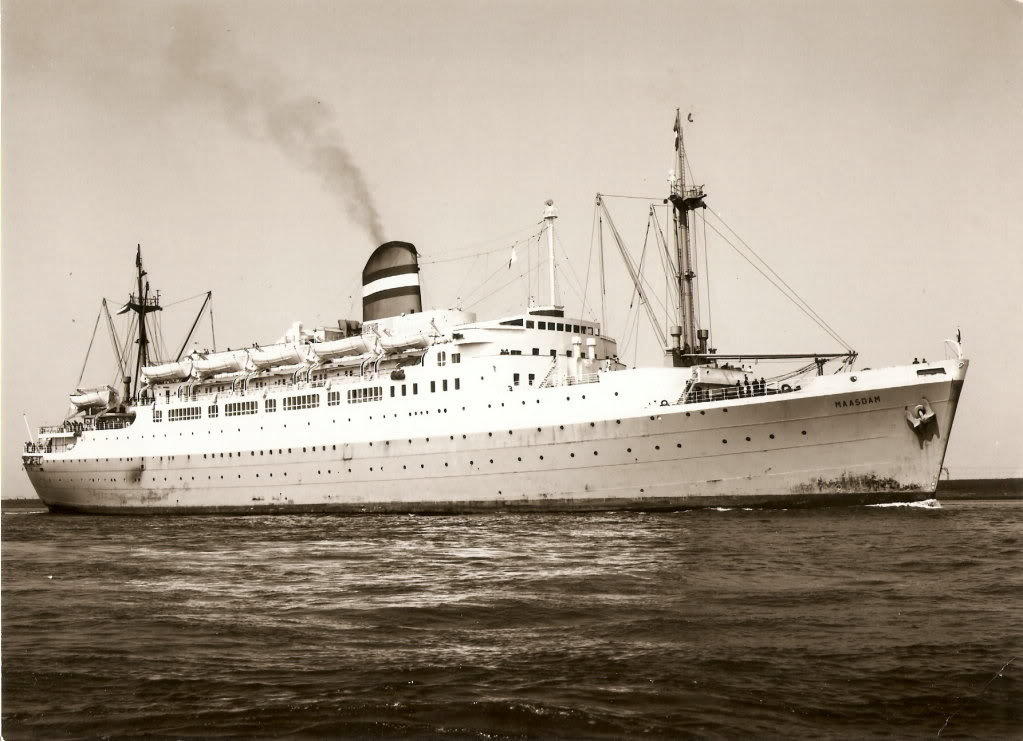
This photo of the ss Maasdam (IV) was taken early in her career and she is seen here approaching her berth in Hoboken, New York
Pertinent facts:
TONN. BRT: 15,024 NRT: 8,976 DWT: 7,057
BUILT AT: N.V. Maatschappij Wilton Feijenoord, Schiedam, The Netherlands.
BUILT IN: 1952 YARD NO: 733
ENGINES: One set of double reduction geared Cross Compound Steam turbines by the General Electric Company, Erie, Pennsylvania, USA.
ENGINE OUTPUT: 8,500 Shp PROPS: One (fixed)
SERVICE SPD: 16.0 Knots MAX.SPD: 17 Knots.
LENGTH.O.A: 153.42 Meters LENGTH.PP: 144.78 Meters
BEAM OA: 21.09 Meters DEPTH: 12.80 Meters
DRAFT:
PAX.CAP: 39 First Class, 854 Tourist Class
CREW: 304
SISTERSHIPS: Ryndam (2)
REMARKS: Bunker capacity 1775 tons of oil at 54 ton a day.
——————————————————————
HISTORY:
Constructed of steel with two full decks and laid down as the hull of a full cargo ship. This was changed during the construction into a passengership as Holland America urgently needed tonnage for the blooming emigrant and tourist class trade and it was quicker to convert a existing design/hull then to start from scratch. This did result in two peculiar little passenger ships. A cargo hull is designed to have a low centre of gravity for it to be a good sea ship. If you put more superstructure on board than orignally planned, then the center of gravity will move upwards and that reduces the sea going qualities of the ship considerably as it becomes much more lively. And that is not good for any ship, but certainly not for a passengership. The designers tried to mitigate this somewhat by putting concrete ballast into the double bottom but it did not alleviate the problem very much.
The company called the two ships the ” thrifty ships” or the “economy liners” as they offered good value for money. The passengers called them “the submarines” as they tended to be more underwater than above. Even if the water was not that bad. Still they sailed full as Holland America provided a good service for a very – thrifty- price. A second result of having been planned as a cargo ship was the engine configuration. Passengerships normally had two screws but the hulls of the Maasdam & Ryndam did not have space for it. The hull was not wide enough to have two propeller shafts running side by side.

One of the Holland America Line advertisements from around the time when the Maasdam came into service
The keel was laid on 19 December 1950 and the hull was launched on 5 April 1952. The ship was baptized by Mrs. Emily Cluett Forwerd – Gips, the wife of the then time Director of the HAL. She was then moved to the fitting out pier and subsequently dry docked between 07 and 09 july.
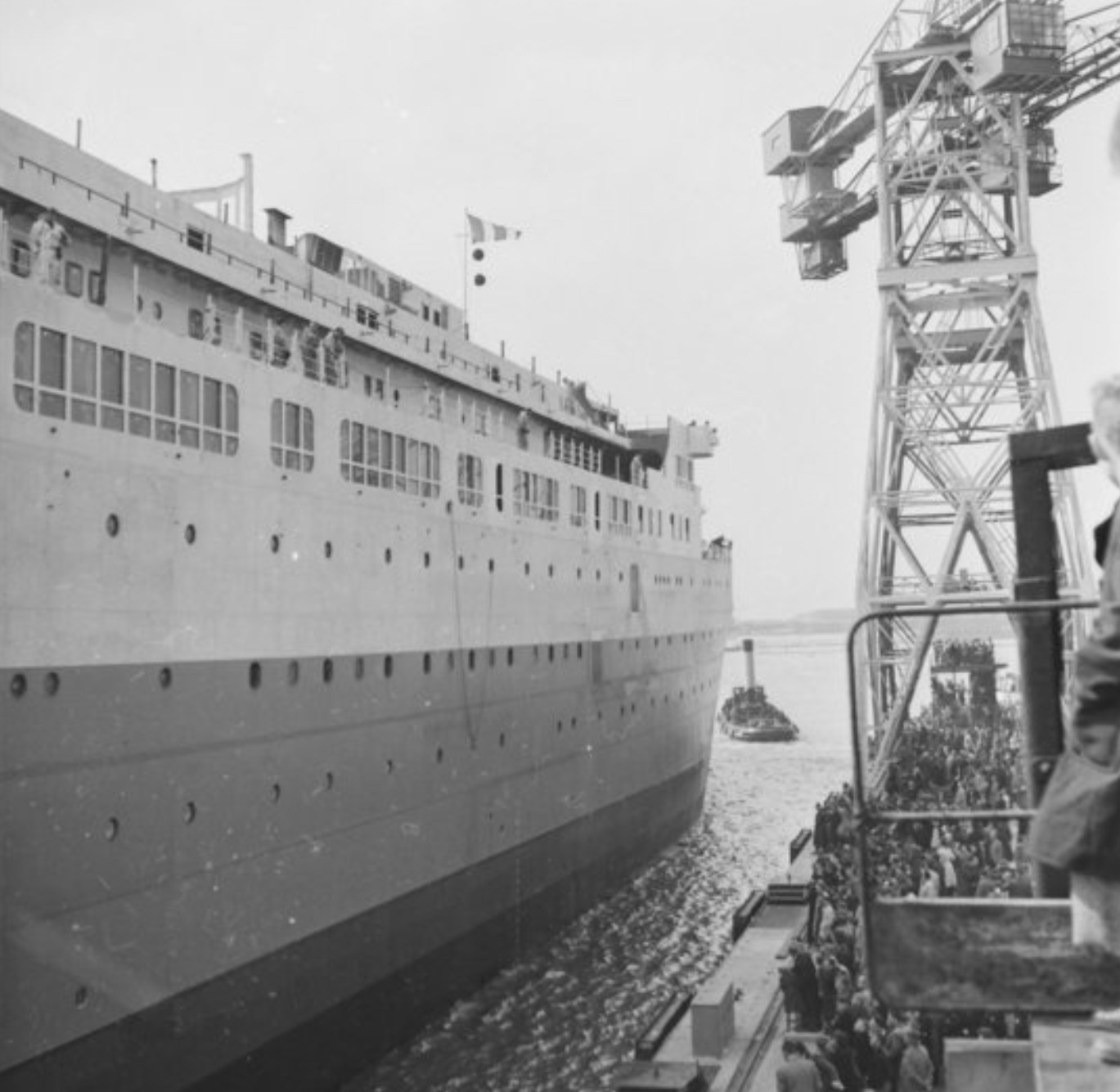
Here we see the hull of the ship being brought alongside de fitting out pier of the shipyard on April 5, the day of her launch.
Delivered to her owners between the 26 and 31 July 1952 when she made her official trial trip in the English channel. On return it was back to dry-dock to inspect the undership between 23 to 26 july at W.F. She commenced her maiden voyage on 11 August sailing from Rotterdam via Le Havre, Southampton and Montreal to New York.
There was not much interest in these “thrifty voyages” by tourist and emigrants across the North Atlantic in the winter so during the months of January, February and March for most of the years, until 1959/60. These years were the most profitable years of the company and with the new ss Rotterdam going on a yearly worldcruise the two ships filled the gap.
On 10 December 1952 the ship hit in dense fog the small tanker Ellen while sailing in the New Waterway off Rotterdam which causes 6 fatal casualties.
On 3 October 1954 the ship collides with the cargoship Tofevo off Rhode Island and returns to New York.
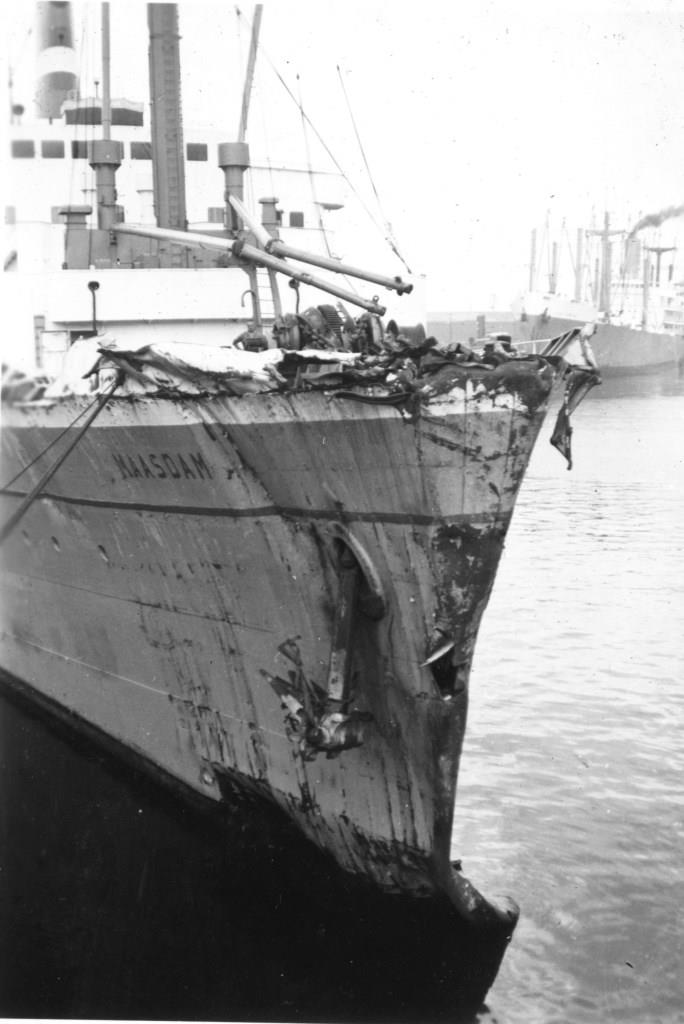
The damaged bow of the ss Maasdam (IV) after colliding with the ms Tovefo outside New York. (Courtesy: collection of Capt. H.L. van Deventer via son R. van Deventer)
The collision took place in fog (1 – 1.15 NM. visibility) and the Maasdam (outbound) was on a near paralel course with the Tofevo (inbound). The progress of the Tovefo was monitored on the radar and it was observed that that ship was going to pass port to port. However the Tofevo was slowly coming closer. Both ships were running at full speed which is not a good idea in the fog., and although the Maasdam stopped when the other ship became visible a collision occured. The Maasdam hit the Tofevo full in the portsdie bow. Radar had only been developed during the 2nd world war for commercial applications and the technique was far from reliable. The ship had to dry dock in New York was was out of service for 3 weeks. During the Board of Inquiry investigation the HAL captain was accused of going too fast in the fog, and relying too much on radar observations. The Board of Inquiry suspended his license for 3 weeks. This did not affect anybody as the captain had retired already due tor reaching his pension age. Holland America refrained from comment as, yes they wanted the ships to sail safely but also wanted the ship to stay on schedule and radar was already considered (by most shipping companies) to be the solution to all the collision problems and thus bringing less need to slow down.
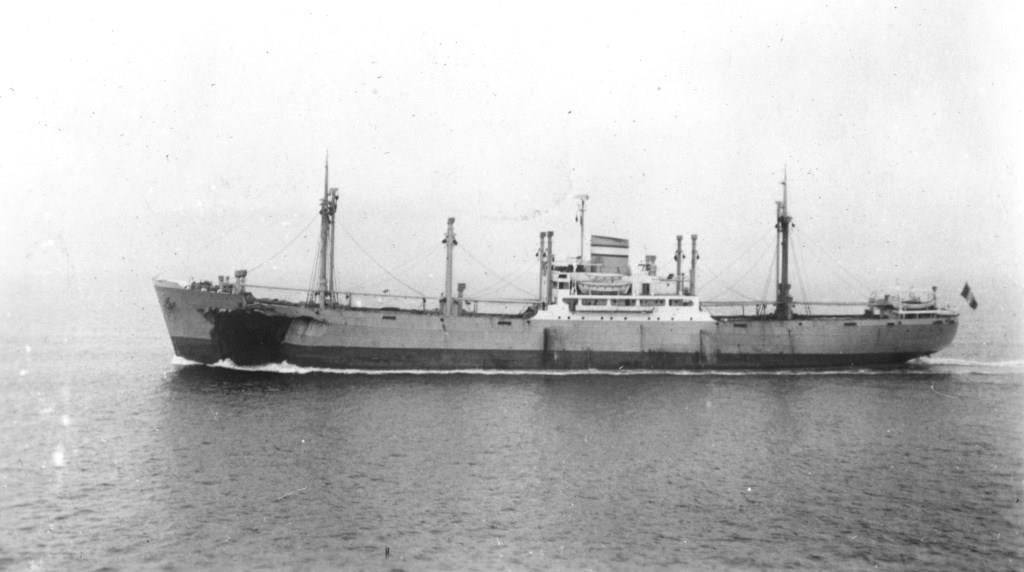
The ms Tovefo with a hole in the portside bow after the collision. (Courtesy: collection of Capt. H.L. van Deventer via son R. van Deventer)Around this time the company also started to experiment with stabelizers. The first commercial ones had appeared on the North Atlanticin 1951, installed on the passenger/cargo ships Parthia and Media of Cunard. Their success made every passenger company scramble to have them installed as well. The first idea came from the Netherland Royal Navy who had designed a moving “flipper” at each side of the hull. During the trial voyage they caused the ship to behave so dangeroulsy that the captain was in a “great hurry” to get back into port again and to have them removed.
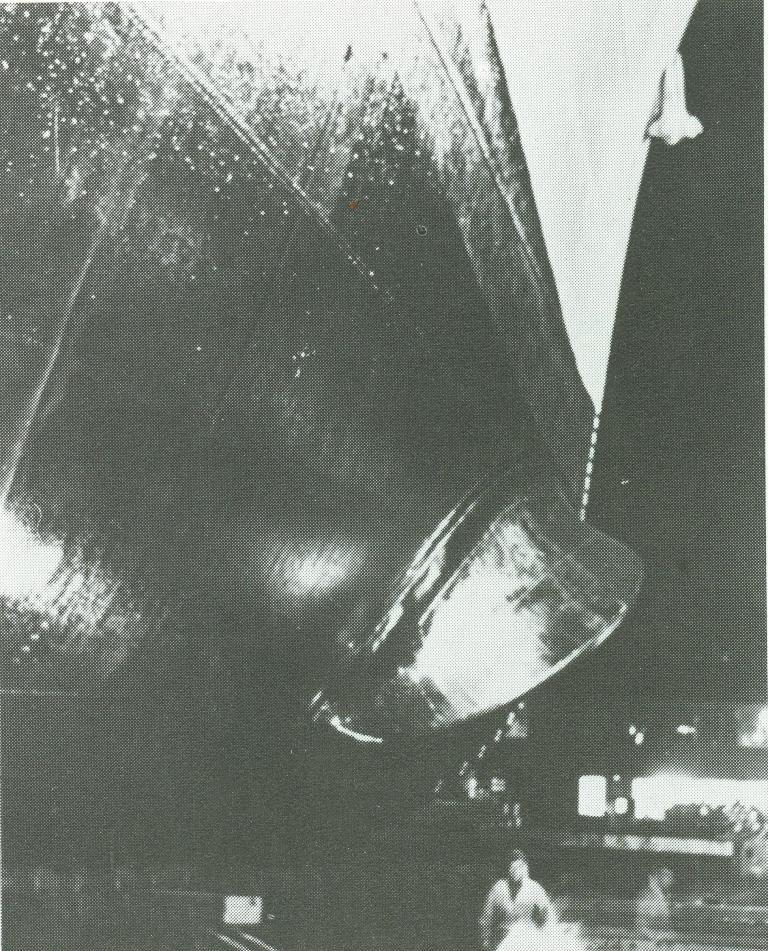
The “flipper” stabelizers installed on the ss Maasdam (IV)
The 2nd test involved installing the stabelizers which had been succesful on the Cunard ships and were made by Denny Brown and these worked well. Hence the ss Maasdam became the first Holland America ship to have stabelizers. No doubt much to the relieve of the passengers on board. However stabelizers only reduce (by about 90%) the rolling of the ship. It does nothing to reduce the pitching (bow movement). Hence the “submarine” tendency was not much reduce.d
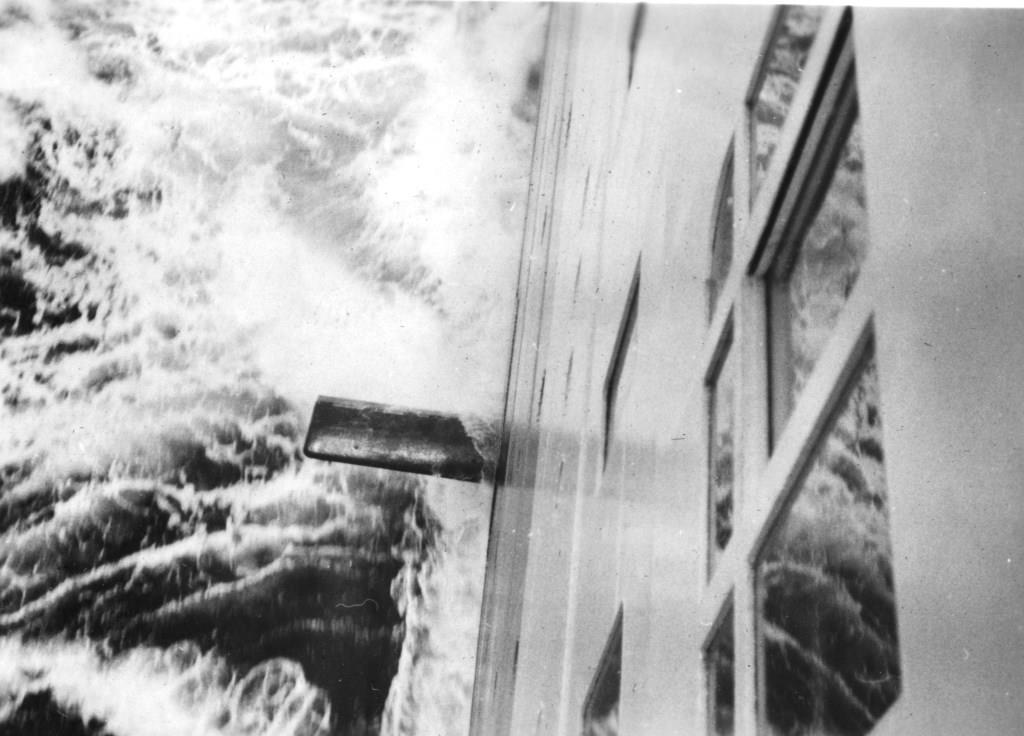
The Sb. stabelizer fin during the trial trip on 19 May 1954. Normally the fin is underwater but part of the test is to reverse the gyroscopic signal and then the stabs enhance the rolling instead of dampening it out. That brings then the fin above water. (Courtesy: collection of Capt. H.L. van Deventer via son R. van Deventer)
During the remainder of the 1950’s. the ship sailed its regular route but also often called at Halifax, to land emigrants. On average 150 to 200. However near the end of June 1956 it landed 902 emigrants in Montreal, basically the full complement of the ship. Nearly all of them were Dutch and from Montreal they took the train westward and a large number ended up in the Vancouver area. Some made it further south and found fertile land east of Portland Oregon in the USA.
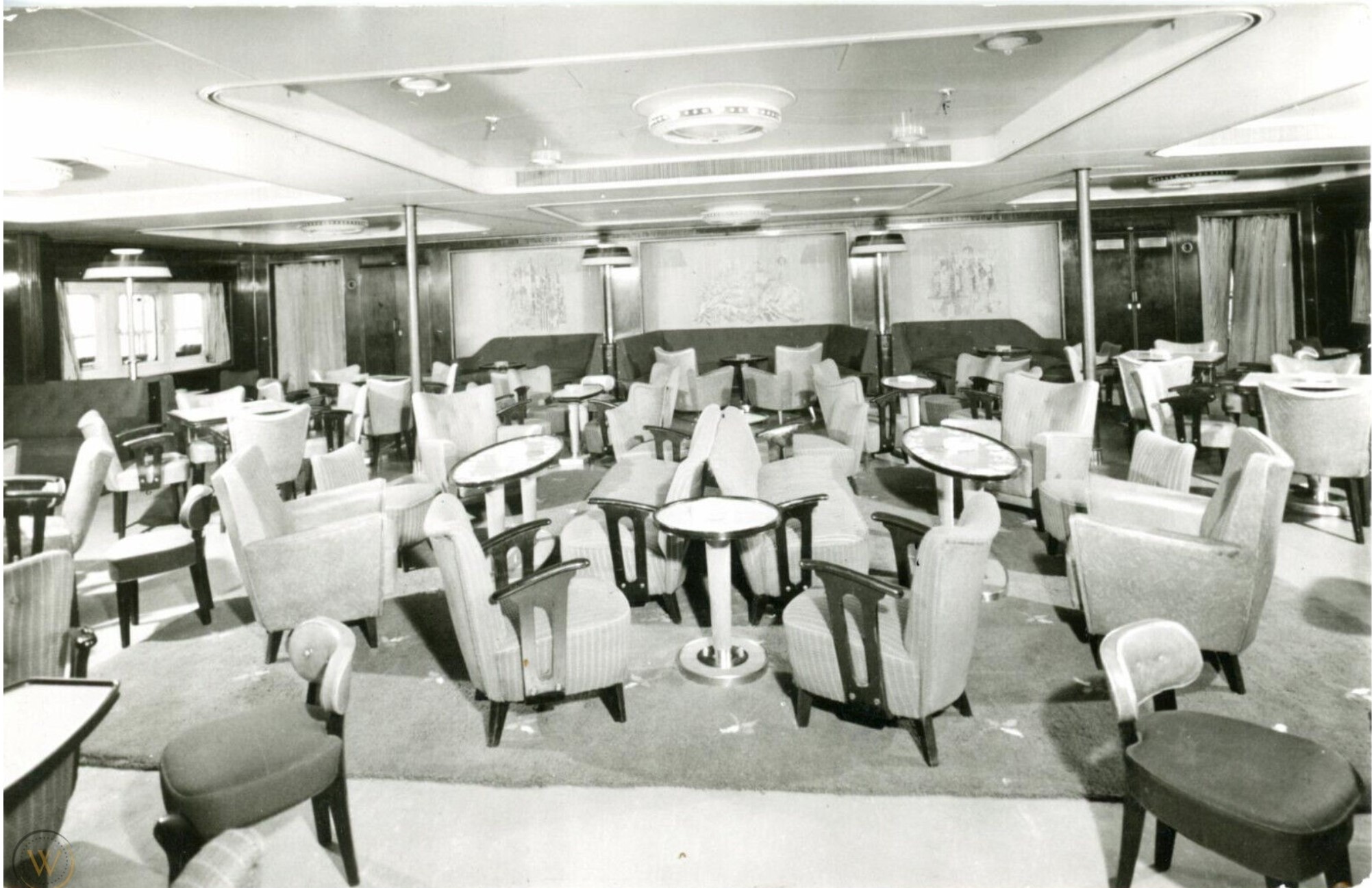
The Tourist Class lounge on board.
De accomodation of the ship consisted out of a very small first class (39 pax.) and a large number, 854, of Tourist Class passengers. The First class was a -not planned- addition to the ship. But in order to have a large Tourist class and comply with the requirements of the North Altantic Passenger Association ( which regulated the tariffs) a First Class was required if one wanted to benefit from the lower Tourist class fares. Hence accommodation was created for 39 passengers around the funnel who had their own day room and restaurant. They could make the North Atlantic crossing there in splendid and posh isolation or just come down to the Tourist Class area during the day time what most of them did.
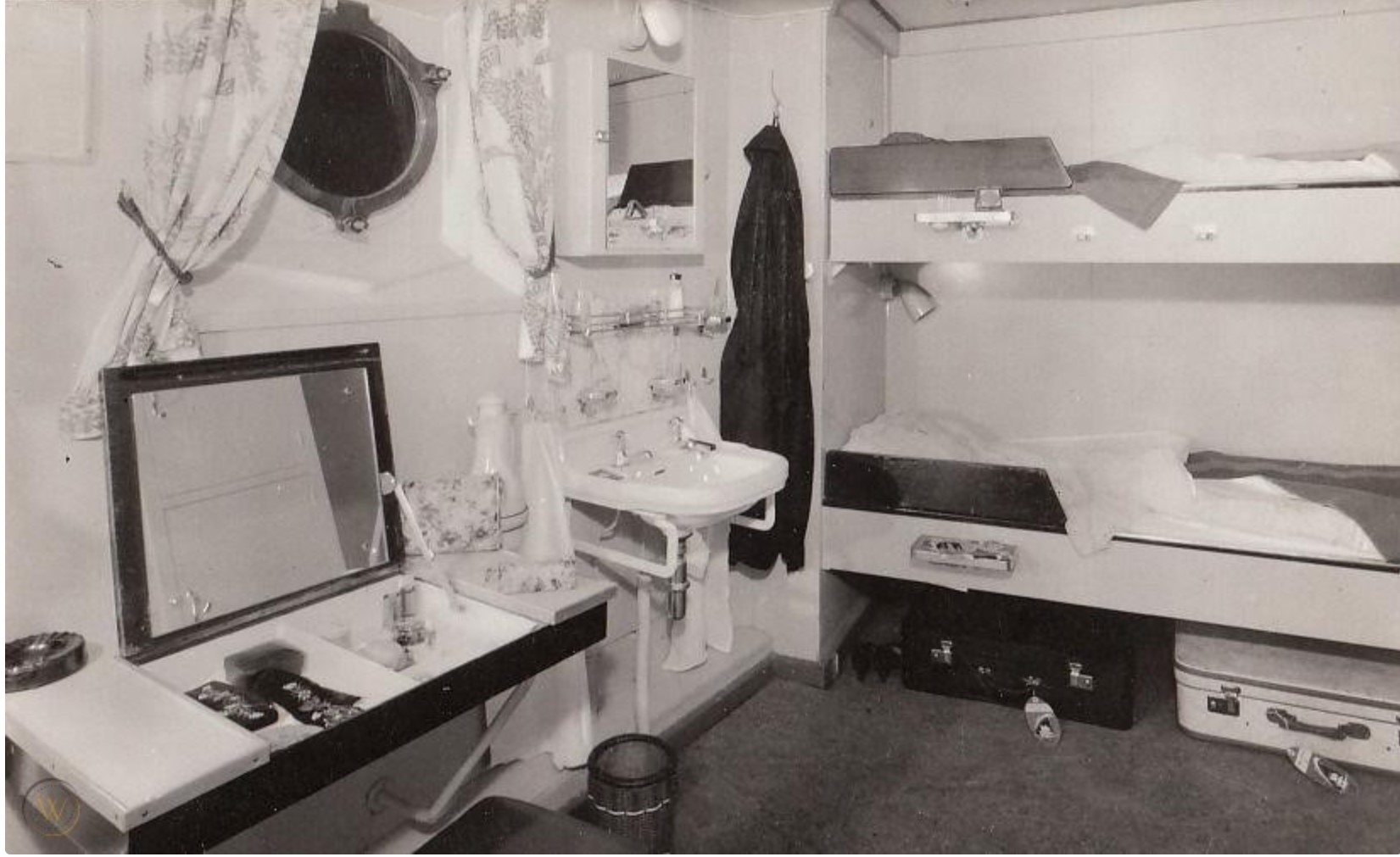
A Tourist Class two berth cabin. To fit close to 900 passengers in a 16000 tons size ship, the cabins were not very large and hence the “bunk bed” configeration figured greatly in the overall design.
During winter time (December to February or March) the ship made cruises from New York to the Caribbean and Nassau. Mostly 11 days to 14 days. Between October and December 1959 it made one long (39 day) cruise from New York to Italy. This was never repeated and anecdotal information indicats that the ship was found too crowded and having too bad seagoing characteristics to be succesful on long voyages in open waters.
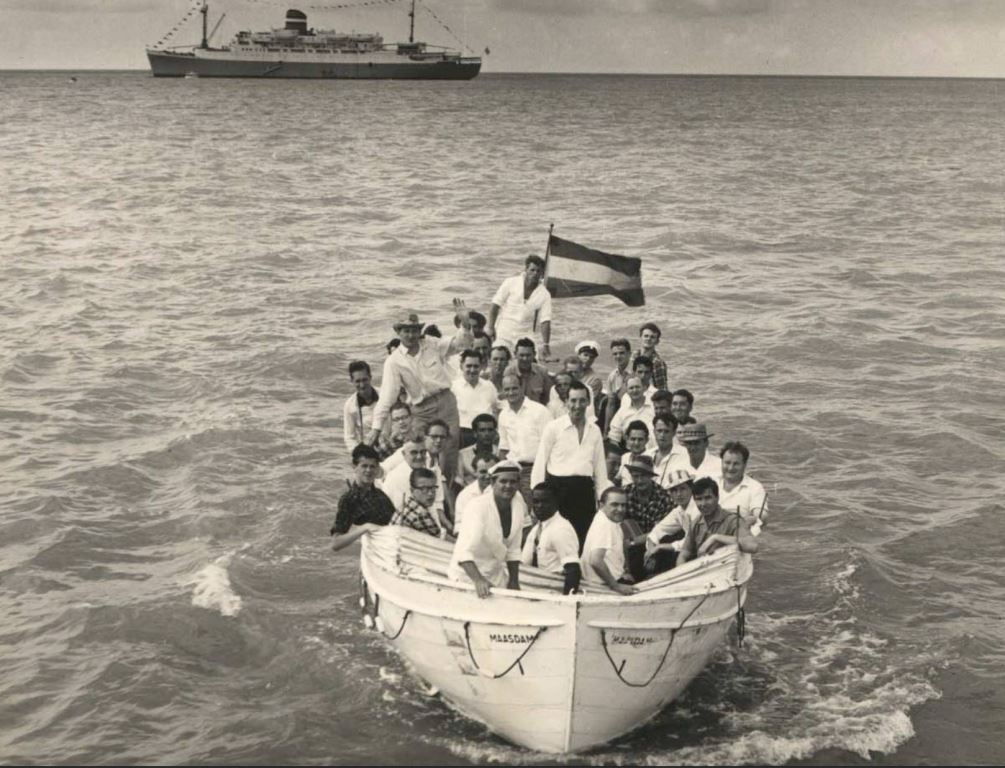
During cruises the ship often had to anchor as many West Indies ports were not very cruise friendly and were to shallow to come alongside in. This photo taken in Dec. 1957 shows the crew going ashore in a lifeboat while the ship is at anchor at Port au Prince, Haiti. For the guests on board the company normally chartered local tenders which were a bit more comfortable. (From the collection of an unknown crewmember)
By the late 1950’s the route from Roterdam to New York was extended with calls at Ireland, with the ports of Galway or Cobh to embark or land passengers. Then in 1963 it was decided to tap into the German market and have the voyage start at Bremerhaven instead of Rotterdam.
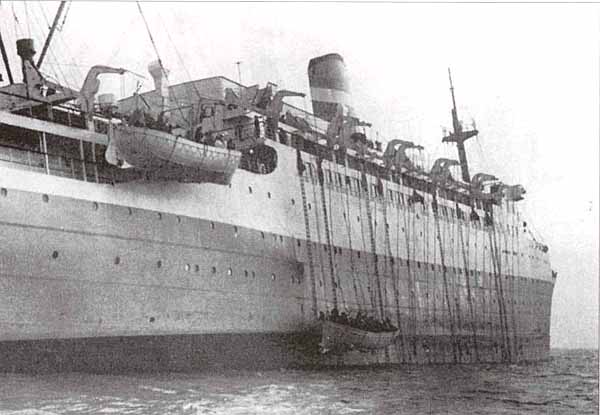
The lifeboats on the ss Maasdam being lowered. the ship developed a list of 10o as a 45 feet gap had been torn in the portside bottom.
On 15 February 1963 while on its first return voyage to Bremerhaven the ship hits the wrecks of the English freighter Harborough and the Russian Kholmogory in the estuary of the river Weser. Due to moving ice flows in the river the wreck buoys had shifted. Most of the ships complement leaves the ship in the lifeboats. The winter of 1963 had been a very harsh one and ice movements in the Weser estuary had been very severe.
The passengers were taken on board by the German pilot boat Gotthilf . The ship did not sink however and managed to reach under her own power the port of Bremerhaven where repairs were carried out at the yard of the Nord Deutscher Lloyd. The planned sailing was taken over by the Seven Seas. Full repairs lasted until april and it was only on 16 April that the ship came back into services and commenced her next departure from Bremerhaven via Southampton and Galway to New York.
The subsequent Board of Inquiry found the pilot at fault as his local knowledge should have been sufficient to know that something was wrong. Also shipside was blamed as it was found that the bridge team had relied too much on the pilot and not done enough to verify if the pilot was doing his job correctly. Holland America considered the pilot responsible as Captain and deck officers had only done one departure from Bremerhaven and thus had no local experience.
With the North Atlantic trade disappearing Holland America tried it with the ship further afield and sent her on a Around the World liner voyage. The idea was to entice Dutch people to visit Australia and New Zealand, to visit family and friends who had emigrated and to pick up passengers in the various ports where air traffic was not yet so well established as on the North Atlantic. Hence on 18 October 1965 the ship sailed from Rotterdam to southampton and then calling at Suez, Colombo, Fremantle, Melbourne, Sydney, Wellington. Returning via the Panama Canal with a bunkering stop at Papeete. followed by calls at Los Angeles, Acapulco, Kingston, New York, Cobh and Southampton. On 10 Feb. 1966 the ship was back in Rotterdam.
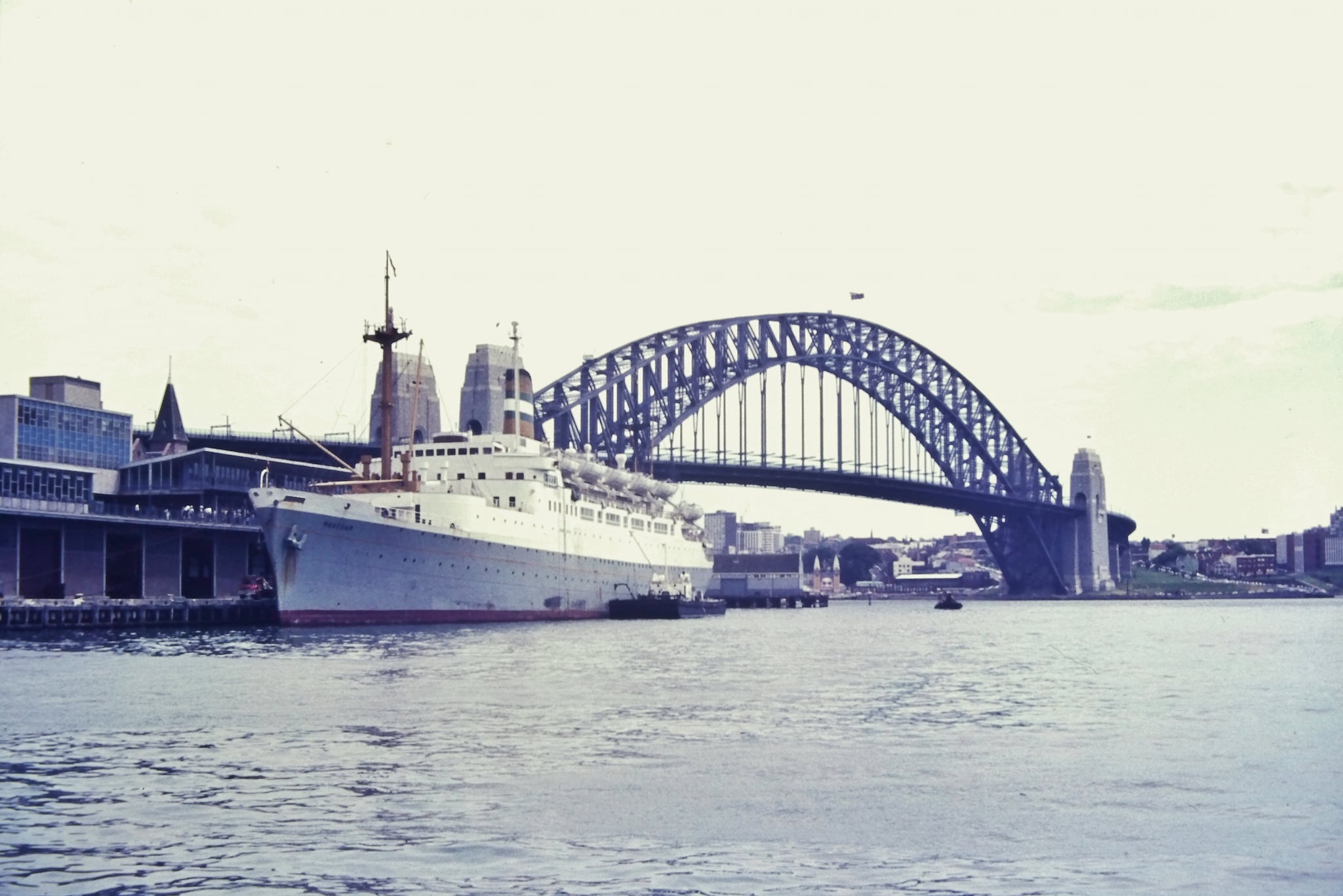
The ss Maasdam (IV) docked in Sydney. (Courtesy Captain Scale)
For the summer of 1967 the ship returned to the North Atlantic and in Autumn 1967 and Spring 1968 two more around the world round trips. For the summer of 1968 she sail on the North Atlantic again, now to the ports of Quebec and Montreal. On 21 May 1968 the announcement to the shipping world is made that the ship has been sold to the Polish Ocean Lines.
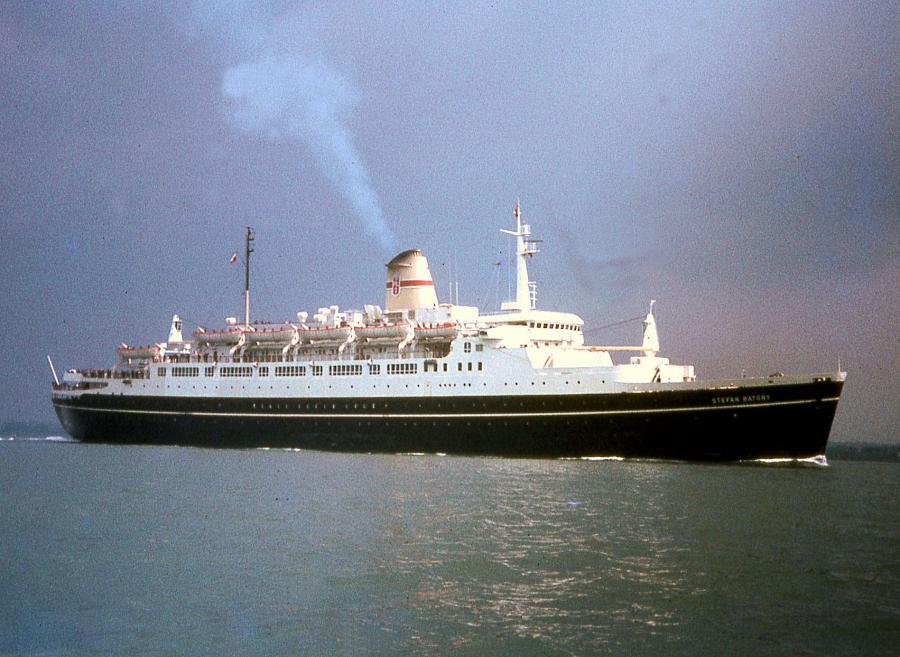
The Stefan Batory, ex Maasdam. Her profile was consdieably changed by chaning the funnel and the bridge front.
On 20 September 1968 the ship departs for the last time from Montreal and is handed over upon return on October 09 to the Polski Linje Oceaniczne Gdansk (Polish Ocean Line) and renamed in Stefan Batory. After a refit at Gdynia the ship enters service with a capacity of 38 First and 739 Tourist Class passengers. (15,043 Brt. 7,170 Dwt. 333 crew)
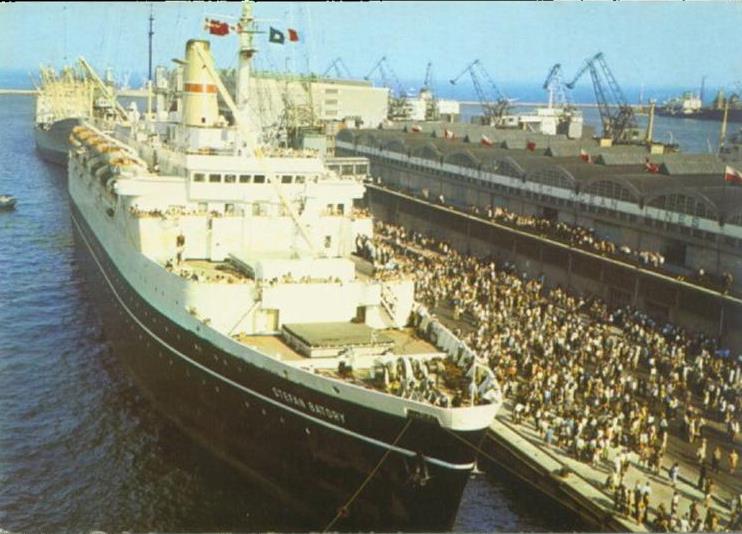
The ss Stefan Batory departing from Gdynia (Gdansk) Poland for a Trans Atlantic crossing. (Couetesy: Company issued postcard_
Cruises in the Mediterranean in the winter and trans Atlantic service in the summer. First departure takes place on 11 April 1969 from Gydnia, via Copenhagen, London and Quebec to Montreal and on return calling at Southampton instead of London. After 1976 First Class tickets are not sold anymore but the public rooms remain in use for the Tourist class passengers. In the same year calls at Rotterdam and Bremerhaven are added. On 19 November 1984 192 of the 608 passengers on board request for political Asylum in Hamburg and remain ashore. In the past 10 years already 130 passengers had done the same, but this was a world record.
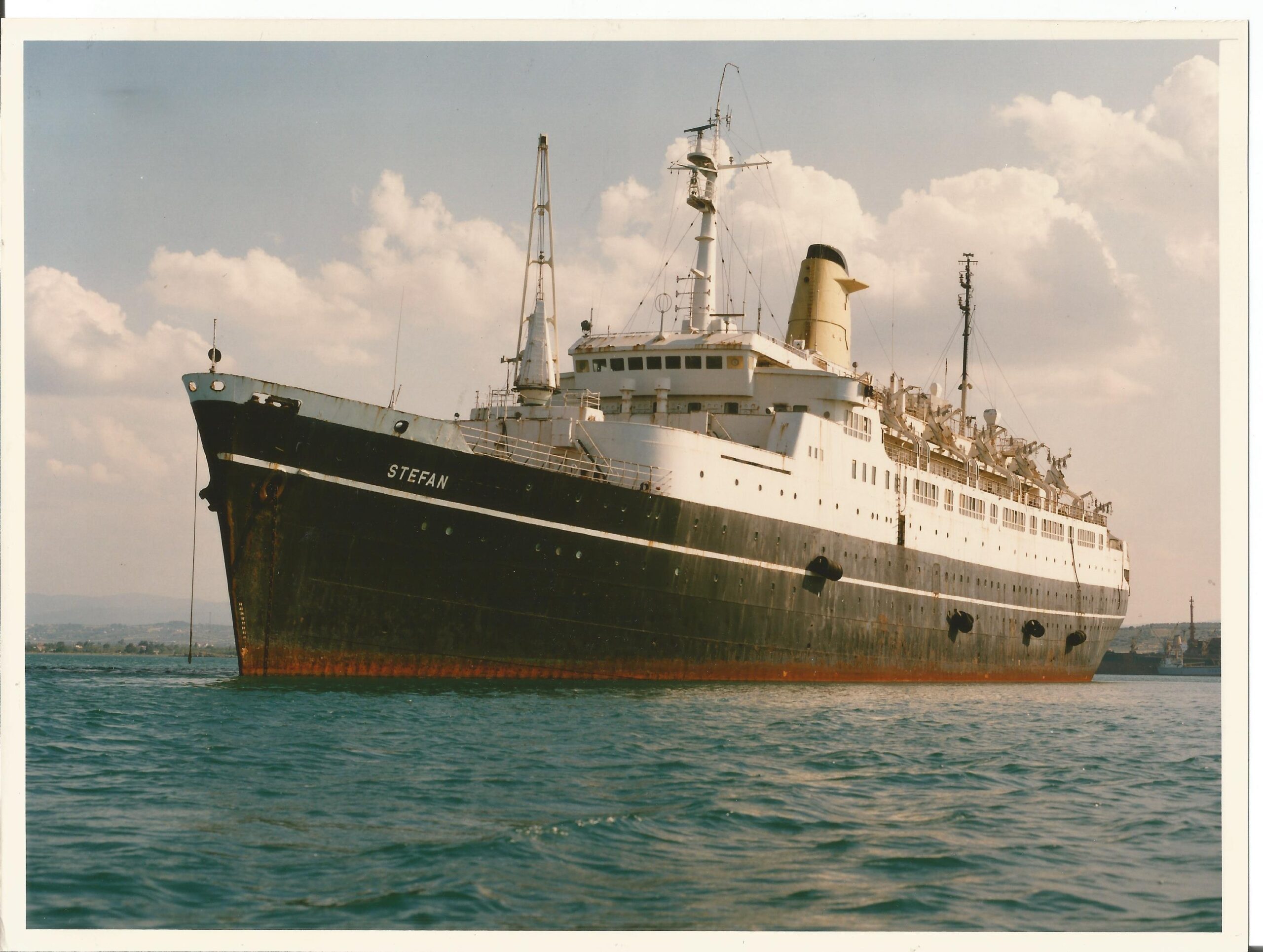
The ss Stefan laid up in Pireaus Greece, awaiting her fate.
In March 1988 the ship is laid up in Gdynia awaiting disposal and transferred to the Hellenic Polish Shipping and Trading Enterprises Ltd. of Panama. On 23 June 1988 it leaves for Flushing roads (the Netherlands) and is anchored there. On 11 November the ship is sold to become a ferry on the Rangoon to Bombay service and is sent to Piraeus for conversion. The ship is resold in early 1989 to Erne Compagnia Maritima S.A. Panama and shortly after to the City Shipping International Company of Nassau Bahama’s. (Stena Line). Renamed in Stefan. (11,693 brt.) and docked at Stockholm in a charter to the Swedish government as a Hotel ship for Refugees.
Sold by Stena in 1991 to A. Lelakis of Piraeus Greece for use as a cruiseship. Departs for Piraeus in tow on 7 August 1993 to the Avlis Shipyard S.A. and brought under the banner of Regency Cruises. Laid up pending funding. On 3 November 1995 Regency Cruises goes bankrupt and all ship are laid up including the Stefan. (Registration: is Courage Maritime Co. of Nassau with the classification as a accommodation ship.)
The ship remained in lay-up as she was too old and small for further use. Hence in 2000 she is sold for scrap and dismantled in Aliaga, Turkey.
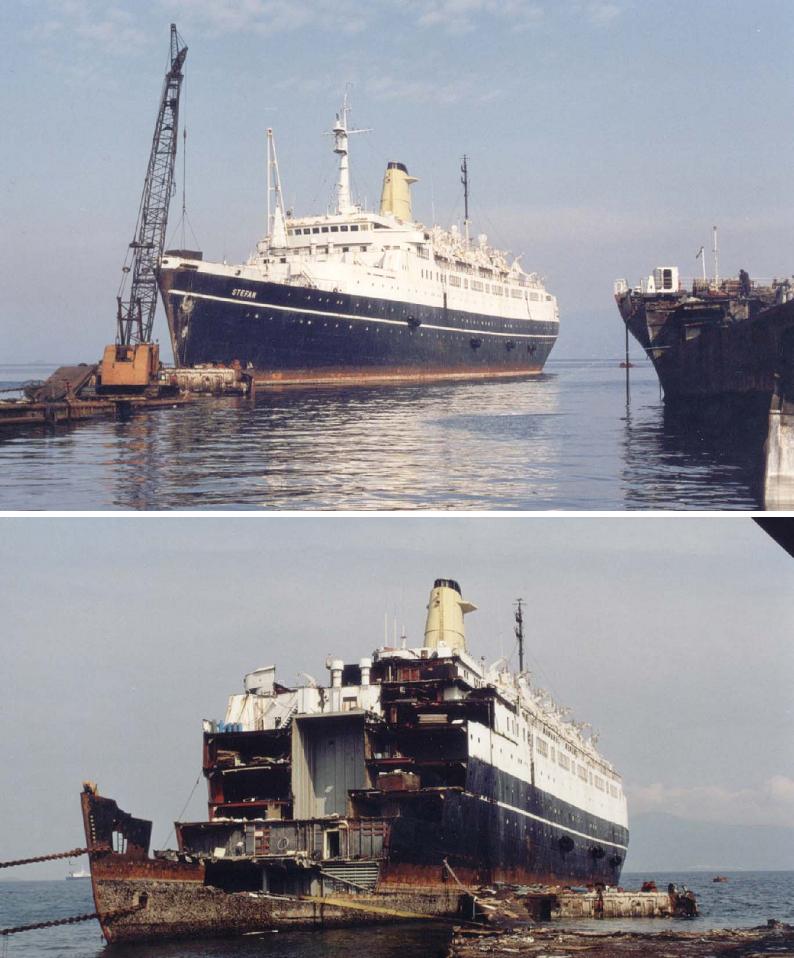
The ss Stefan arriving at Aliaga and subsequently beached and scrapped.
Captains:
Johannes van Gaart 15 Jul. 1952 – 23 Aug. 1955
Coenraad Bouman 23 Aug. 1955 – 04 Apr. 1956
Hendrik Hogervorst 16 Apr. – 195 – 28 Apr. 1958
Cornelis Kooyman 01 May 1958 – 17 Sep. 1961
Eduard Heymans 17 Sep. 1961 – 15 Jan. 1963
Anthony Lagaay Jr. 21 Jan. 1963 – 17 Apr. 1963
Jan v. Roosendaal 17 Apr. 1963 – 15 Jan. 1965
Note: Relieve captains not yet listed.
1965 onwards, the company records are incomplete. Captain Roosendaal, Georg Scale, Berend Kunst, Antony Lagaay and Jacob Pothof served off and on, on the ship. when the precise dates become available the listing will be update.
Last Captain of the ship
Berend Westra 13 Jun. 1968 – 09 Oct. 1968.
Sources:
a. Captain Albert Cruiseship database and photo collection
b. Logbooks HAL archive as kept by the Municipal Archives of the city of Rotterdam.
c. Captain Hendrik van Deventer & Captain Georg Scale.
Last Updated: 09 Jan. 2025.
(More interior photos to follow when time is available. For now please
check: http://ssmaritime.com/rijndam-maasdam.htm
This is a very nice website by Dr.. Rabbi Reuben Goosens with lots of interior material.
